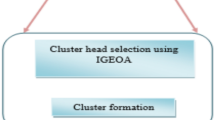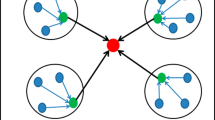Abstract
Energy optimization is one of the open issues in wireless sensor networks. Most of the work focuses on clustering techniques to reduce the energy consumption and enhancement of stability period. In this paper we have proposed a novel region based routing protocol for the rise in stability duration and lifetime improvement. The whole sensing area is divided among nine regions and dedicated to different variety of nodes. Dynamically changing cluster head election probability has been exploited for heterogeneous wireless sensor networks. In this paper, cluster head selection is based on residual energy of nodes, region in which the node is residing and minimum number of clusters per round. The proposed protocol is simulated using MATLAB and the results establish that it performs better than the ETSSEP in terms of stability period, throughput and lifetime. Proposed routing protocol frames more stable routing environment than the ETSSEP. It is also evident from the results that stability is increased by 35.03% in comparison to ETSSEP. Lifetime and throughput have also been improved by 23.16% (for 50% live node) and 25.58% respectively.








Similar content being viewed by others
References
Akyildiz IF, Su W, Sankarasubramaniam Y, Cayirci E (2002a) A survey on sensor networks. Commun Mag IEEE 40:102–114. https://doi.org/10.1109/MCOM.2002.1024422
Akyildiz IF, Su W, Sankarasubramaniam Y, Cayirci E (2002b) Wireless sensor networks: a survey. Comput Netw 38:393–422. https://doi.org/10.1016/S1389-1286(01)00302-4
Kumar S, Verma SK, Kumar A (2015) Enhanced threshold sensitive stable election protocol for heterogeneous wireless sensor network. Wirel Pers Commun 85:2643–2656. https://doi.org/10.1007/s11277-015-2925-x
Hammoudeh M et al (2017) Wireless sensor network border monitoring system: deployment issues and routing protocols. IEEE Sens J 17(8):2572–2582. https://doi.org/10.1109/JSEN.2017.2672501
Pal V, Singh G, Yadav RP (2015) Cluster head selection optimization based on genetic algorithm to prolong lifetime of wireless sensor networks”. Procedia Comput Sci 57:1417–1423. https://doi.org/10.1016/j.procs.2015.07.461
Hammoudeh M, Newman R, Dennett C, Mount S, Aldabbas O (2015) Map as a service: a framework for visualising and maximising information return from multi-modalwireless sensor networks. Sensors 15(9):22970–23003. https://doi.org/10.3390/s150922970
Ren X, Liang W, Xu W (2014) Maximizing charging throughput in rechargeable sensor networks. In: Computer communication and networks (ICCCN), 23rd international conference on. IEEE, 2014. https://doi.org/10.1109/ICCCN.2014.6911792
Jiang Q, Ma J, Li G et al (2014) An efficient ticket based authentication protocol with unlinkability for wireless access networks. Wirel Pers Commun 77:1489–1506. https://doi.org/10.1007/s11277-013-1594-x
Wang F, Liu J (2011) Networked wireless sensor data collection: issues, challenges, and approaches. IEEE Commun Surv Tutor 13(4):673–687. https://doi.org/10.1109/SURV.2011.060710.00066
Bughin J, Chui M, Manyika J (2010) Clouds, big data, and smart assets: ten tech-enabled business trends to watch. McKinsey Q 56(1):75–86
Tiwari A, Ballal P, Lewis FL (2007) Energy-efficient wireless sensor network design and implementation for condition-based maintenance. ACM Trans Sens Netw. https://doi.org/10.1145/1210669.1210670
Sharma R, Lobiyal DK (2016) Multi-gateway-based energy holes avoidance routing protocol for WSN. Inform Multidiscip Dig Publ Inst 3(2):5. https://doi.org/10.3390/informatics3020005
Sharma R, Lobiyal DK (2015) In Proficiency analysis of AODV, DSR and TORA ad-hoc routing protocols for energy holes problem in wireless sensor networks. Proced Comput Sci 57:1057–1066. https://doi.org/10.1016/j.procs.2015.07.380
Olariu S, Stojmenovic I (2006) Design guidelines for maximizing lifetime and avoiding energy holes in sensor networks with uniform distribution and uniform reporting. In: Proceedings of the 25th IEEE international conference on computer communications, IEEE INFOCOM, Barcelona, Spain, 23–29 April 2006; pp 1–12. https://doi.org/10.1109/INFOCOM.2006.296
Arioua M, Assari YE, Ez-zazi I, Oualkadi AE (2016) Multi-hop cluster based routing approach for wireless sensor networks. Procedia Comput Sci Madrid 83:584–591. https://doi.org/10.1016/j.procs.2016.04.277
Heinzelman WR, Chandrakasan A, Balakrishnan H (2000) Energy-efficient communication protocol for wireless microsensor networks, system sciences. In: Proceedings of the 33rd annual Hawaii international conference, pp 4–7. https://doi.org/10.1109/HICSS.2000.926982
Manjeshwar A, Agrawal DP (2001) TEEN: a routing protocol for enhanced efficiency in wireless sensor networks. In: 1st international workshop on parallel and distributed computing issues in wireless networks and mobile computing, April. https://doi.org/10.1109/IPDPS.2001.925197
Younis O, Fahmy S (2004) Heed: a hybrid, energy-efficient distributed clustering approach for Ad hoc sensor networks. IEEE Trans Mob Comput 3(4):660–669. https://doi.org/10.1109/TMC.2004.41
Tripathy AK, Chinara S (2012) Comparison of residual energy-based clustering algorithms for wireless sensor network. ISRN Sens Netw. https://doi.org/10.5402/2012/375026
Saini P, Sharma AK (2010) Energy efficient scheme for clustering protocol prolonging the lifetime of heterogeneous wireless sensor networks. Int J Comput Appl 6(2):30–36
Smaragdakis G, Matta I, Bestavros A (2004) SEP: a stable election protocol for clustered heterogeneous wireless sensor networks. In: Second international workshop on sensor and actor network protocols and applications
Qing L, Zhu QX, Wang MW (2006) Design of a distributed energy efficient clustering algorithm for heterogeneous wireless sensor networks. Comput Commun 19(12):2230–2237. https://doi.org/10.1016/j.comcom.2006.02.017
Kumar D, Aseri TC, Patel RB (2009) EEHC: energy efficient heterogeneous clustered scheme for wireless sensor networks. Comput Commun 32(4):662–667. https://doi.org/10.1016/j.comcom.2008.11.025
Dehghani S, Pourzaferani M, Barekatain B (2015) Comparison on energy-efficient cluster based routing algorithms in wireless sensor network. Procedia Comput Sci 72:535–542. https://doi.org/10.1016/j.procs.2015.12.161
Femi AA, Jeremiah DD (2011) An enhanced stable election protocol (SEP) for clustered heterogeneous WSN. Department of Information Science, University of Otago, New Zealand
Kashaf A, Javaid N, Khan ZA, Khan IA (2012) TSEP: threshold-sensitive stable election protocol for WSNs. In: 10th international conference on frontiers of information technology (FIT), vol 164, no 168, pp 17–19. https://doi.org/10.1109/FIT.2012.37
Kaur K, Kapoor R (2019) MCPCN: multi-hop clustering protocol using cache nodes in WSN. Wirel Pers Commun 109:1727–1745. https://doi.org/10.1007/s11277-019-06649-8
Author information
Authors and Affiliations
Corresponding author
Rights and permissions
About this article
Cite this article
Rastogi, A., Rai, S. A novel protocol for stable period and lifetime enhancement in WSN. Int. j. inf. tecnol. 13, 777–783 (2021). https://doi.org/10.1007/s41870-020-00576-9
Received:
Accepted:
Published:
Issue Date:
DOI: https://doi.org/10.1007/s41870-020-00576-9




